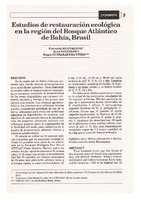Estudios de restauración ecológica en la región del Bosque Atlántico de Bahía, Brasil
Date
1994-09-01Author
Montagnini, Florencia
Fanzeres, Anna
Guimaraes Da Vinha, Sergio
Metadata
Show full item recordAbstract
En la región sur de Bahía el bosque primario está siendo cortado principalmente para actividades agrícolas. Para disminuir la presión sobre el bosque natural remanente, es necesario aumentar la productividad de las áreas degradadas que proveen alimento, madera y forraje a los grupos que ejercen esta presión. Los sistemas agroforestales y las plantaciones arbóreas mixtas pueden representar prácticas de uso de la tierra, adecuadas para áreas con problemas similares de degradación de recursos. Los objetivos de este estudio fueron la identificación de especies arbóreas nativas con influencia positiva sobre la restauración de la fertilidad del suelo, para utilizarlas en el diseño de plantaciones arbóreas mixtas y sistemas agroforestales.
El estudio se enfocó en 20 especies nativas escogidas por su potencial económico. Todas las parcelas eran parte de un arboretum en la Estación Biológica Pau Brasil (CEPLAC-Porto Seguro, Bahia); todos los árboles tenían aproximadamente la misma edad, 14-15 años. Los suelos se muestrearon bajo las 20 especies y un bosque secundario de 20 años, una plantación arbórea mixta y el bosque nativo, a cuatro profundidades (0-5 cm, 5-15 cm, 15-30 cm y 30-45 cm) para análisis de pH; N, P, K, Ca y Mg. También se recolectaron muestras de tejidos (la hojarasca y las hojas verdes) y se realizó análisis de N, P, K, Ca y Mg.
Se detectaron efectos positivos al menos en la mitad de los parámetros estudiados en 15 especies arbóreas. Efectos positivos en más de 5 parámetros fueron observados en
B. virgilioides, l. affinis, P. pterosperma (especies fijadoras de N), A psilophylla, C. echinata, Cassia spp., C. lucens, H. aurea (especies leguminosas, no fijadoras de N), B. macrophyllum, B. grandis, E. ovata, L. Pisonis, L. hypoleuca (de otras familias). El suelo en la plantación mixta exhibió valores similares de pH, C, N, Mg, una concentración levemente mayor de P y menor cantidad de K y Mg que el suelo del bosque primario. Four hundred years ago the forest of the Atlantic coast of Brazil was approximately 100 million hectares. Today, human settlement and industrialization have reduced the forest to < 15% of its original size. In southern Bahia the primary forest is being cleared primarily for agricultural reasons. To decrease pressure on the remaining natural forest, it is necessary to increase the productivity of the degraded areas making food, wood and fodder available to the groups exerting pressure on the primary forest. Agroforestry systems and mixed tree plantations may represent environmentally sound land use practices for areas with similar problems of resource degradation. The goals of this research were to identify indegenous tree species with a positive influence on soil fertility restoration and to use these data for designing experimental mixed-tree plantations and agroforestry systems.
The study focused on 20 native species chosen for their ecological significance and their potential economic use. All the stands were part of an arboretum at Pau Brasil Ecological Station (CEPLAC- Porto Seguro, Bahía) and were planted in 1974-75; thus all the trees were approximately the same age, 14-15 years old, at the time this research was conducted. Soils for chemical analysis and bulk density were sampled under the 20 species, a 20-year old capoeira, a mixed-species plantation and the native forest. Soil samples were taken at four depths (0-5 cm, 5-15 cm, 15-30 cm, 30-45 cm) for measurements of pH, N, P, K, Ca, and Mg. Tissue samples (litter and green leaves) were also collected and analyzed for N, P, K, Ca and Mg.
Positive effects on at least half of the parameters studied were detected under 15 species. Positive effects on more than five parameters were noted under B. virgilioides,
l. affinis, P. pterosperma (N-fixing species); A. psilophylla, C. echinata, Cassia spp., C. luscens, H. aurea (legumínous, non-N-fixing); B. macrophyllum, B. grandis, E. ovata, L. pisonis, L. hypoleuca (of other families). The mixed plantation had similar soil pH, C, N, Mg, slightly higher P and lower K and Mg than the primary forest: thus, this system apparently represents an intermedíate situation wíth respect to the pure stands.
Collections
- Revista Yvyraretá [360]
The following license files are associated with this item:




